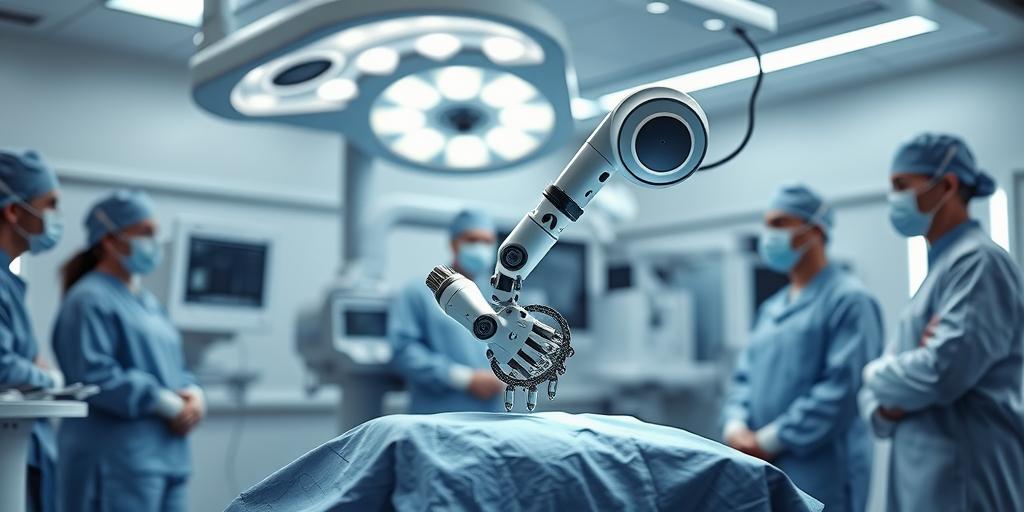Robotics in Healthcare: Revolutionizing Surgery, Care, and Assistance in 2025
The healthcare industry is on the cusp of a technological revolution, with robotics leading the charge. As we move into 2025, the integration of robotics into surgery, patient care, and general assistance is poised to transform how medical services are delivered. This article explores the current state and future potential of robotics in healthcare, highlighting key advancements and their impact on patients and providers.
Robotics in Surgery: Precision and Minimally Invasive Procedures
Robotic surgery has evolved significantly, offering enhanced precision, dexterity, and control compared to traditional methods. Systems like the da Vinci Surgical System enable surgeons to perform complex procedures through small incisions, resulting in reduced pain, shorter hospital stays, and faster recovery times for patients.
- Current Applications:
- Cardiac Surgery: Robotic assistance in coronary artery bypass grafting (CABG) and valve repair.
- Urology: Prostatectomies with improved nerve-sparing techniques.
- Gynecology: Hysterectomies and myomectomies with minimal scarring.
- General Surgery: Gallbladder removals and hernia repairs with greater precision.
- Future Trends:
- Increased Autonomy: Development of robotic systems with AI-driven decision-making capabilities.
- Enhanced Imaging: Integration of advanced imaging technologies like augmented reality (AR) for real-time guidance.
- Remote Surgery: Expanding access to specialized surgical care in underserved areas through remote-controlled robots.
Robotics in Patient Care: Enhancing Support and Monitoring
Beyond the operating room, robots are increasingly used to assist in patient care, providing support and monitoring to improve outcomes and alleviate the workload of healthcare professionals.
- Applications in 2025:
- Medication Delivery: Robots that autonomously deliver medications to patients, reducing errors and improving adherence.
- Rehabilitation: Robotic exoskeletons and therapy devices that aid in physical rehabilitation and improve motor function.
- Patient Monitoring: Continuous monitoring of vital signs and patient status using wearable sensors and robotic systems.
- Telepresence Robots: Robots that facilitate remote consultations and monitoring, especially beneficial for elderly or homebound patients.
Robotics in Assistance: Automating Tasks and Improving Efficiency
Robots are also playing a crucial role in automating routine tasks and improving the overall efficiency of healthcare facilities.
- Roles in 2025:
- Cleaning and Disinfection: Autonomous robots that maintain hygiene standards in hospitals, reducing the risk of infections.
- Logistics and Transportation: Robots that transport supplies, equipment, and specimens within healthcare facilities, streamlining operations.
- Reception and Information: Robots that assist with patient check-in, provide information, and guide visitors.
- Data Collection and Analysis: Robots that collect and analyze patient data to improve care coordination and decision-making.
Challenges and Considerations
While the potential of robotics in healthcare is immense, several challenges need to be addressed to ensure successful integration:
- Cost: The high cost of robotic systems can be a barrier to adoption for many healthcare facilities.
- Training: Healthcare professionals require specialized training to operate and maintain robotic equipment.
- Regulation: Clear regulatory frameworks are needed to govern the use of robotics in healthcare and ensure patient safety.
- Ethical Considerations: Addressing ethical concerns related to autonomy, data privacy, and the potential for job displacement.
Conclusion
As we approach 2025, robotics is set to revolutionize healthcare, enhancing surgery, improving patient care, and automating routine tasks. By addressing the associated challenges, healthcare providers can harness the power of robotics to deliver more efficient, precise, and patient-centered care. The future of healthcare is here, and it is driven by robotics.
